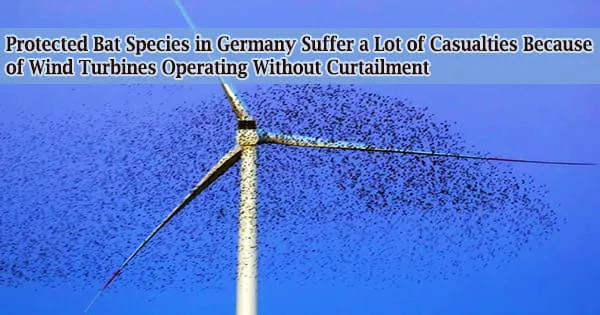Rare and protected bats frequently perish at wind turbines (WT). This is the reason why new wind turbine operations are sometimes halted during times of intense bat activity. However, older wind turbines continue to operate unimpeded.
By meticulously documenting bat carcasses in the area around such ancient turbines, a scientific team led by the Leibniz Institute for Zoo and Wildlife Research (Leibniz-IZW) has now developed an excellent estimate of bat death rates at such old turbines. Per wind turbine, 70 bats per month on average perished.
Even if these numbers cannot be applied directly to all 20,000 of Germany’s aging turbines, there is a critical need for action. In an essay that was published in the academic journal “Global Ecology and Conservation,” the authors contend that the operation of old turbines should be modified to comply with the current regulations for new turbines.
The common noctule (Nyctalus noctula) and Nathusius’s pipistrelle (Pipistrellus nathusii), two endangered and protected species of bats, frequently perish when they collide with the rotor blades of wind turbines, which minimize greenhouse gas emissions. Population decreases are a result of the losses.
This serious issue is addressed at new and recently constructed wind turbines by temporarily shutting down turbines when bat activity is excessive, a procedure used for only about ten years in Germany. A curtailment regime is not in place for older wind turbines, which make up about 75% of all onshore turbines in Germany.
“Since we see that these curtailments actually substantially reduce the risk for bats to die at wind turbines, we have to assume that there are considerable fatalities at unregulated turbines and at turbines in unfavourable locations,” says Dr. Christian Voigt, Head of the Department of Evolutionary Ecology at the Leibniz-IZW.
At a wind farm with three turbines that had been operating since 2001, Voigt and his colleagues evaluated the number of bat victims in 2021, with the unsettling finding that 70 bats per turbine perished over the course of two summer months.
The number of victims at this wind farm is anticipated to be high when extrapolated over the wind farm’s twenty-year lifespan. The scientific team gathered bat carcasses under the three turbines of the wind farm west of Berlin in the months of August and September in order to obtain these accurate numbers.
“Precise counts of victims are a methodological challenge, as we are far from finding all bat victims for two reasons,” explains co-author Dr. Carolin Scholz. “Firstly, in tall vegetation search teams only find a fraction of the carcasses, and secondly, the carcasses are removed quickly by foxes, crows, birds of prey, and other scavengers.”
Since both mouse and bat carcasses had a high likelihood of being discovered, the researchers decided to test the search effectiveness using similar-sized wild mouse carcasses. They also determined how long mouse carcasses that were dispersed at random around the turbines stayed at each location.
“We noted that even experienced search teams only find one in six (17%) bat victims and that just under half of the carcasses were removed by other animals within 24 hours,” says Scholz. “After the first 24 hours, almost all remaining carcasses remained at their spot for about a week. We could therefore generate reliable correction factors for our fatality counts, based on search efforts that took place at an average interval of two days.”
This result is alarming enough because we have to assume that 20,000 unregulated turbines in Germany will have a high number of bat casualties over the course of their lifetime. This is unacceptable for endangered species with declining populations such as the common noctule, especially as bats are strictly protected at national and EU levels.
Dr. Christian Voigt
The study determined that a total of 209 bats perished at the three wind turbines over the course of two months of the migratory season using both adjustment factors.
Christian Voigt believes that although the estimate of 70 casualties per wind turbine per year is high compared to earlier figures, it is still conservative because, among other things, some of the migration periods did not match with the study period. Since there are several bushes and hedges next to the turbines, it is conceivable that the placement of this specific wind farm is particularly unsuitable from the perspective of bat conservation.
“This result is alarming enough because we have to assume that 20,000 unregulated turbines in Germany will have a high number of bat casualties over the course of their lifetime,” says Voigt. “This is unacceptable for endangered species with declining populations such as the common noctule, especially as bats are strictly protected at national and EU levels.”
The authors advise that old wind turbines should operate in accordance with the present legal framework for new turbines, for example, on the need for required curtailment during times of high bat activity.
Dismantling should also be taken into account in cases where outdated turbines are situated in particularly unfavorable locations because the energy transition’s objectives to lower greenhouse gas emissions in energy production shouldn’t be achieved unilaterally at the expense of biodiversity.





